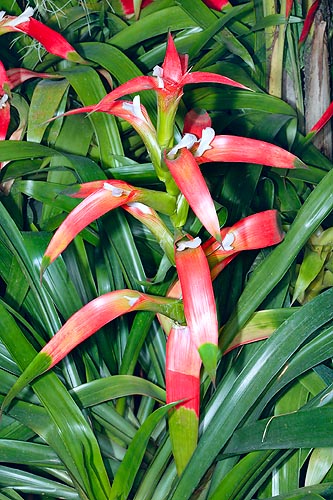Family : Bromeliaceae

Text © Pietro Puccio

English translation by Mario Beltramini

Very ornamental but doesn’t like the cold © G. Mazza
The Guzmania wittmackii (André) André ex Mez (1896) is native to the humid forests of the coastline and of the Andes zones, up to 2000 m of altitude, of Colombia and Ecuador.
The genus is honoured to the Spanish naturalist Anastasio Guzman (†1807); the species is dedicated to the German botanist Max Carl Ludwig Wittmack (1839-1929).
Evergreen herbaceous plant, monocarpic (bearing fruit only one time during its existence), acaulescent, epiphytic, it has a funnel-shaped rosette of unarmed glossy dark green leaves, long up to 60-80 cm and 2-3 cm broad, placed in way to form a rosette with central cavity usually full of water. The floral scape, at the centre of the rosette, is short, covered by bracts resembling to the leaves, and ends with an about 80 cm long inflorescence, formed by oblong floral bracts, prominent and wrapping the base, of decreasing length towards the apex, usually of a magenta colour, which remain unchanged for about four months. The flowers, inside the bracts, are white with about 9 cm long petals.
It reproduces, besides by seed, by vegetative way through the new plants coming out from axillary gemmae between the leaves and which can be detached when they have reached the dimension of one third of the mother plant. The plant has originated several hybrids with differently coloured bracts, utilized, in particular, as indoor plants. Plant of remarkable ornamental value, both for the foliage and for the particular shape and colour of the inflorescence, it can be cultivated in open air, in shaded position, in the tropical and humid subtropical climates, both as epiphytic and as terrestrial, on very aerated, porous, draining and rich of organic substance substrata.
Rather sensitive to the cold, as its foliage gets damaged already with temperatures just over the 0 °C. The plant, and even more its hybrids, can be both cultivated in pot for indoor spaces decoration in shaded position, avoiding the direct sun which would damage the leaves, with temperatures preferably not under the 16 °C and a high ambient humidity; in presence of dry air and high temperatures, this can be incremented with short lasting nebulisations, utilizing water at room temperature and not calcareous, in order not to cause anti-aestethic dots on the leaves. In summer, some water can be left in the central cavity formed by the rosette of leaves, renewing frequently the same for avoiding the it becomes a nest of larvae of mosquito, whilst in winter it is better to leave it dry thus avoiding possible rottenness.
Synonyms: Thecophyllum wittmackii André (1889).
→ For general notions about BROMELIACEAE please click here.
